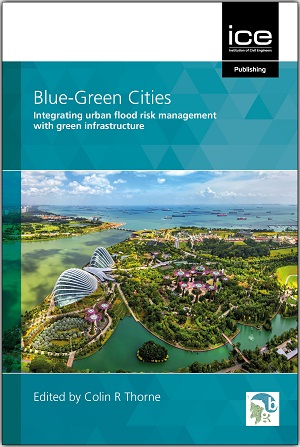Blue-Green Cities: Integrating urban flood risk management with green infrastructure
This book reveals how cities can enhance their flood risk management systems while simultaneously delivering
- increased water security
- improved air and water quality
- reduced urban heat island effects
- carbon sequestration
- access to natural areas for recreation and conservation
- enhanced social benefits and economic vitality.
Book Reviews
Blue-Green Cities is about the management of water and the opportunities to create and support nature with blue and green spaces in urban areas. The book is wide-ranging and includes technical aspects of flood and water management as well as the essential social and economic perspectives.
Blue-Green Cities provides a clear view of where thinking and practice has got to, using numerous UK examples, but also showing how other countries have implemented the ideas that using blue or green infrastructure can be as hydraulically effective as traditional pipes, concrete and channelised system.
Richard Ashley, Emeritus Professor of Urban Water, Department of Civil and Structural Engineering, University of Sheffield, UK
Blue-Green Cities is one of the very few books to examine in detail the performance of blue green infrastructure in cities from various angles based on international case studies. It provides guidance to flood risk management professionals and inspires researchers working in this field to move beyond their domain. Definitely highly recommended.
Chris Zevenbergen, Professor of Flood Resilience of Urban Systems, IHE Delft/TU Delft, Netherlands
01. Urban Flood Risk Management: the Blue-Green Advantage - Emily O’Donnell and Colin Thorne
02. Overcoming barriers to innovation in urban flood risk management - Emily O’Donnell, Shaun Maskrey, Maggie Skenderian, Helen O’Brien and Jonathan Vann
03. Coupled surface/sub-surface modelling to investigate the utility of Blue-Green infrastructure - Chris Kilsby, Vassilis Glenis and Robert Bertsch
04. Two-dimensionsal, hydrodynamic modelling to investigate the utility of Blue-Green approaches - Sangaralingam Ahilan, Nigel Wright and Mingfu Guan
05. Performance of storm water treatments trains incorporating Blue-Green and grey infrastructure - Scott Arthur and Brian D’Arcy
06. Restoration of urban streams to create Blue-Green assets and corridors - Jenny Mant, Colin Thorne, Josh Burch and Marc Naura
07. Understanding citizen and community behaviours and preferences - Jessica Lamond, Glyn Everett and Kit England
08. Evaluating the multiple co-benefits generated by Blue-Green spaces, corridors and infrastructure - Richard Fenner and Chris Digman
09. Applying the flood footprint concept to calculate the full costs of urban floods - David Mendoza-Tinoco, Dabo Guan, Malcolm Morgan, Richard Fenner, Colin Thorne and Emily O’Donnell
10. Towards a Blue-Green future: the Newcastle declaration, national policy and progress – Colin Thorne


No customer reviews